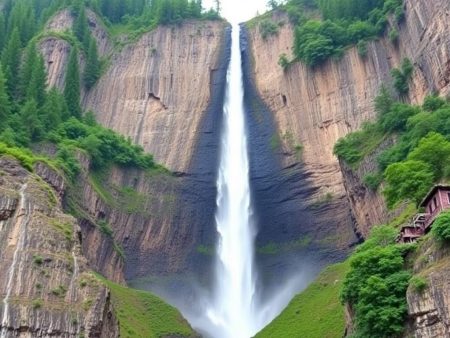Cuando la gente piensa en la montaña más alta del mundo, generalmente se le viene a la mente el monte Everest. Pero ¿y si el título de la montaña más alta en realidad perteneciera a un gigante escondido bajo las olas? En las profundidades del océano Pacífico se encuentra el Mauna Kea, un volcán inactivo en Hawái que desafía todo lo que sabemos sobre los picos imponentes.
Elevándose más de 33.500 pies desde su base en el fondo del océano hasta su cumbre sobre el mar
Descubre Mauna Kea: la montaña más alta del mundo bajo el agua
Cuando la gente piensa en la montaña más alta del mundo, generalmente se le viene a la mente el monte Everest. Pero ¿y si el título de la montaña más alta en realidad perteneciera a un gigante escondido bajo las olas? En las profundidades del océano Pacífico se encuentra el Mauna Kea, un volcán inactivo en Hawái que desafía todo lo que sabemos sobre los picos imponentes.
Convierte la altura de las personas, edificios, montañas y monumentos más altos a m, pies y pulgadas para comparar
0' 0" es igual a 0,0 cm o 0,00 m.
El Mauna Kea, que se eleva más de 33.500 pies desde su base en el fondo del océano hasta su cumbre sobre el nivel del mar, es técnicamente más alto que el Everest. Su verdadera altura sigue siendo un misterio para muchos, ya que la mayor parte de su enorme estructura está sumergida bajo el agua. Este gigante submarino no solo redefine lo que significa ser la montaña más alta, sino que también guarda secretos fascinantes sobre las maravillas geológicas de la Tierra.
Entendiendo la montaña más alta bajo el agua
El Mauna Kea, situado en Hawái, es la montaña más alta bajo el agua cuando se mide desde la base hasta la cima. Si bien su elevación sobre el nivel del mar es de 13.796 pies, su altura real supera los 33.500 pies, ya que gran parte de su estructura se encuentra debajo del océano Pacífico. Esta medida supera los 29.032 pies de altura del monte Everest desde el nivel del mar hasta la cima.
El Mauna Kea se originó como un volcán en escudo, que se formó a partir de sucesivos flujos de lava a lo largo de un millón de años. Su parte sumergida comprende casi el 60% de su altura total, oculta bajo miles de pies de agua. Esta base submarina lo distingue de montañas como el Monte Everest, que se elevan desde la tierra.
Los geólogos consideran que Mauna Kea es el resultado del punto caliente hawaiano, donde el magma asciende a través de la corteza terrestre para formar islas volcánicas. Sigue atrayendo el interés científico por conocer las formaciones montañosas submarinas y los ecosistemas oceánicos que prosperan alrededor de sus laderas sumergidas.
A pesar de estar en gran parte oculto, Mauna Kea representa uno de los hitos geológicos más notables de la Tierra, desafía las perspectivas convencionales sobre la altura de las montañas.
¿Qué hace que Mauna Kea sea la montaña submarina más alta del mundo?
La extraordinaria altura de Mauna Kea se debe a que se encuentra bajo el océano y a que se eleva inmensamente sobre el nivel del mar. Esta combinación le otorga una distinción única entre los picos monumentales de la Tierra.
Datos geográficos sobre Mauna Kea
Mauna Kea se encuentra en la Gran Isla de Hawái, parte del archipiélago hawaiano. Su cumbre se encuentra a 4.200 metros sobre el nivel del mar, pero su base se encuentra a más de 6.000 metros por debajo de la superficie del océano. El volcán se formó hace más de un millón de años debido a la actividad volcánica en el punto caliente hawaiano. Entre los volcanes hawaianos, se considera inactivo; se estima que su última erupción ocurrió hace más de 4.000 años.
La montaña alberga diversas zonas climáticas, que van desde la selva tropical en sus regiones más bajas hasta las condiciones desérticas alpinas cerca de su cumbre. La nieve cubre con frecuencia la cima durante los meses de invierno. Mauna Kea alberga algunos de los observatorios astronómicos más avanzados del mundo debido a sus cielos despejados y su mínima contaminación lumínica.
Por qué el Mauna Kea es más alto que el Monte Everest
Si se mide desde la base hasta la cima, el Mauna Kea tiene una altura de más de 33.500 pies, superando los 29.032 pies sobre el nivel del mar del monte Everest. El Everest comienza su ascenso desde una elevación base elevada en la meseta tibetana, mientras que la base del Mauna Kea se encuentra en las profundidades del océano Pacífico. Esta parte sumergida representa casi 60% de la altura total del Mauna Kea.
El segmento submarino de Mauna Kea está compuesto por flujos de lava basáltica, que forman una base sólida sobre el fondo del océano. Con el tiempo, la acumulación de sedimentos ha ocultado parcialmente sus laderas inferiores, pero esto no disminuye su altura geológica. Si se comparan ambas montañas basándose únicamente en la elevación de la cumbre sobre el nivel del mar, el Everest sigue siendo más alto. Sin embargo, en altura total, Mauna Kea lidera como la montaña más alta bajo el agua y en la Tierra.
La formación de montañas submarinas
Las montañas submarinas se forman a través de procesos geológicos complejos, que a menudo implican actividad volcánica y movimientos tectónicos. Estas formaciones pueden tardar millones de años en emerger por completo, creando paisajes sumergidos espectaculares.
Actividad volcánica y sumersión
La mayoría de las montañas submarinas se originan a partir de la actividad volcánica. El magma asciende a través de la corteza terrestre en los límites de las placas tectónicas o en puntos calientes volcánicos, enfriándose y solidificándose para formar estructuras rocosas. Con el tiempo, las repetidas erupciones volcánicas acumulan capas de lava, creando formaciones imponentes. La inmersión se produce cuando el peso de la montaña hace que el fondo marino se hunda o que el nivel del mar suba, cubriendo partes de estas estructuras.
Mauna Kea, por ejemplo, se formó a partir de erupciones del punto caliente hawaiano, con su base enraizada en lo profundo del lecho marino. Aunque gran parte de la montaña está sumergida, su origen volcánico también contribuye a su composición rocosa estratificada y estructura inclinada, típica de los volcanes escudo.
Cómo surgen estas montañas con el paso del tiempo
Las montañas submarinas emergen a través de la deposición continua de lava y la elevación tectónica. Con cada erupción se acumula material nuevo, mientras que la elevación geológica puede elevar gradualmente secciones por encima del nivel del mar. Si los procesos de erosión son limitados y el crecimiento excede las tasas de inmersión, es posible que partes de la montaña acaben rompiendo la superficie del océano.
En el caso de las montañas que permanecen bajo el agua, como la base sumergida de Mauna Kea, la actividad geológica continua mantiene su crecimiento. Por el contrario, los movimientos más lentos de las placas tectónicas o la menor actividad volcánica pueden detener su surgimiento, dejando estas montañas ocultas bajo el océano durante milenios.
Características únicas de Mauna Kea
Mauna Kea destaca no solo por su inmensa altura, sino también por su importancia ecológica, científica y cultural. Su estructura única, que abarca ecosistemas oceánicos y terrestres, crea oportunidades para la exploración y el descubrimiento.
Diversidad de la vida marina
Las laderas sumergidas de Mauna Kea albergan una rica variedad de vida marina. Arrecifes de coral, esponjas y organismos de aguas profundas prosperan a lo largo de su base submarina. Los científicos han registrado especies como peces y crustáceos bioluminiscentes en sus regiones más profundas y frías. Las zonas de transición donde sus laderas emergen por encima del agua albergan especies intermareales, lo que crea un hábitat dinámico. Estos ecosistemas resaltan cómo los gradientes ambientales desde el fondo del océano hasta la cima sustentan diversas formas de vida marinas y terrestres.
Importancia para la ciencia y la cultura
Mauna Kea posee un valor excepcional para la investigación científica y el patrimonio cultural. Los astrónomos se benefician de su gran altitud y de la mínima perturbación atmosférica para observar galaxias distantes. Sus cielos despejados albergan los Observatorios de Mauna Kea, una colección de telescopios avanzados que despiertan el interés mundial por la astronomía.
Para los nativos hawaianos, Mauna Kea es un lugar sagrado que simboliza la conexión con sus antepasados y los cielos. Las prácticas y los mitos tradicionales vinculan la montaña con historias de la creación y un significado espiritual. Se siguen realizando esfuerzos para equilibrar el avance científico con la preservación de su patrimonio cultural e histórico.
Desafíos en la medición de montañas submarinas
La medición de montañas submarinas, como el Mauna Kea, presenta importantes dificultades debido a la profundidad del océano y a las limitaciones tecnológicas. Estos desafíos complican la obtención de datos precisos sobre las estructuras sumergidas.
Limitaciones de la tecnología
La tecnología existente tiene dificultades para mapear con precisión las características submarinas. Los sistemas de sonar, que se utilizan habitualmente para mapear el fondo marino, pueden producir datos incompletos a profundidades extremas porque las ondas sonoras se dispersan a grandes distancias. La altimetría satelital ofrece capacidades cartográficas más amplias, pero tiene dificultades para captar detalles más finos, especialmente debajo de capas gruesas de sedimentos. Los vehículos submarinos autónomos (AUV) avanzados ofrecen una mejor resolución, pero están limitados por el alcance operativo y los altos costos, lo que hace que la cartografía a gran escala sea ineficiente.
Por ejemplo, los barcos equipados con sonares cartografian partes sumergidas de montañas como Mauna Kea, pero la resolución disminuye a medida que aumenta la profundidad. Las mejoras en las tecnologías de obtención de imágenes de aguas profundas y las reducciones de costos son esenciales para mejorar la precisión de los mapas submarinos.
Navegando por profundidades extremas
Operar a profundidades extremas presenta desafíos logísticos y ambientales importantes. La presión del agua aumenta aproximadamente 15 libras por pulgada cuadrada por cada 33 pies de profundidad, lo que requiere un equipo especialmente diseñado para soportar fuerzas intensas. Esta limitación mecánica restringe el acceso a las partes más profundas de las montañas submarinas. Las fuertes corrientes y la mala visibilidad complican aún más la exploración segura, lo que a menudo reduce la calidad de los datos.
Por ejemplo, los vehículos que estudian la base sumergida de Mauna Kea deben soportar presiones superiores a 15.000 libras por pulgada cuadrada, lo que requiere materiales y diseño avanzados. Además, la coordinación de misiones en áreas oceánicas remotas presenta dificultades relacionadas con el despliegue y la recuperación de equipos.
Por qué Mauna Kea merece reconocimiento
Mauna Kea es una maravilla geológica debido a su extraordinaria altura, su formación única y su importancia científica. Su altura total, medida desde su base en el fondo del océano hasta su cumbre, supera los 33.500 pies, superando al monte Everest. A diferencia de los picos terrestres, la mayor parte de la estructura de Mauna Kea se encuentra bajo el agua, lo que lo convierte en un gigante oculto que a menudo escapa al reconocimiento.
Su importancia va más allá de la altura. Para los científicos, Mauna Kea ofrece información valiosa sobre las formaciones volcánicas submarinas y la actividad tectónica, ya que se originó en el punto caliente hawaiano hace más de un millón de años. El proceso de su creación, que incluye sucesivos flujos de lava y levantamiento geológico, pone de relieve la dinámica de la corteza terrestre y las regiones volcánicas.
Ecológicamente, la montaña sustenta diversos hábitats marinos a lo largo de sus laderas sumergidas. Arrecifes de coral, esponjas y organismos bioluminiscentes prosperan alrededor de la estructura submarina, lo que contribuye a la formación de ecosistemas vibrantes que son fascinantes y esenciales para la biodiversidad oceánica.
La ubicación de la cumbre por encima de las nubes, con una mínima interferencia atmosférica, aumenta su valor para los astrónomos. Al albergar algunos de los observatorios más avanzados del mundo, Mauna Kea se ha convertido en un centro mundial de investigación astronómica. Su ubicación remota y sus cielos nocturnos despejados permiten a los científicos estudiar objetos celestes distantes con una precisión excepcional.
Para los nativos hawaianos, Mauna Kea representa un profundo significado cultural y espiritual. La montaña es sagrada y simboliza una conexión entre los cielos y su herencia ancestral. Preservar este legado cultural y, al mismo tiempo, adaptarse a los avances científicos sigue siendo una prioridad para la comunidad y las partes interesadas a nivel mundial.
La prominencia submarina de Mauna Kea, sus contribuciones ecológicas, su potencial astronómico y su reverencia cultural lo distinguen colectivamente como un hito que merece mayor conocimiento y apreciación.
Conclusión
La imponente presencia de Mauna Kea, tanto sobre el océano como debajo de él, muestra la increíble complejidad y belleza de las formaciones naturales de la Tierra. Su combinación única de importancia geológica, ecológica, científica y cultural la convierte en mucho más que una montaña: es un símbolo de descubrimiento y conexión.
Desde su base submarina hasta su cumbre, Mauna Kea invita a la curiosidad y al respeto, recordándonos las maravillas ocultas que se esconden bajo la superficie del océano. Su historia sigue inspirando a científicos, exploradores y promotores culturales por igual, demostrando que las montañas más altas no siempre son visibles a primera vista.
Preguntas frecuentes
¿Cuál es la montaña más alta del mundo?
Si bien el Monte Everest es la montaña más alta sobre el nivel del mar con 29.032 pies, Mauna Kea en Hawaii es la montaña más alta del mundo cuando se mide desde su base en el fondo del océano hasta su cumbre, con un total de más de 33.500 pies.
¿Qué altura tiene Mauna Kea sobre el nivel del mar?
El Mauna Kea se eleva 13.796 pies sobre el nivel del mar. Sin embargo, gran parte de su altura está sumergida bajo el agua, lo que hace que su altura total supere los 33.500 pies desde la base hasta la cima.
¿Por qué se considera que Mauna Kea es más alto que el monte Everest?
La base del Mauna Kea comienza en lo profundo del lecho marino y, cuando se mide desde su base hasta la cima, supera la altura del monte Everest. El Everest es más alto sobre el nivel del mar, pero más bajo en altura total.
¿Dónde se encuentra Mauna Kea?
Mauna Kea se encuentra en la Gran Isla de Hawái. Es un volcán inactivo que se originó a partir de la actividad volcánica hace millones de años.
¿Qué hace que Mauna Kea sea importante para los astrónomos?
La gran altitud de Mauna Kea, sus cielos despejados y su mínima contaminación lumínica lo convierten en un lugar ideal para la astronomía. Alberga algunos de los observatorios más avanzados del mundo.
¿Cómo se formó Mauna Kea?
Mauna Kea se formó a través de repetidas erupciones volcánicas a lo largo de millones de años. Los flujos de lava construyeron su enorme estructura y el punto caliente hawaiano continúa influyendo en la actividad volcánica de la región.
¿Qué porcentaje de Mauna Kea está bajo el agua?
Aproximadamente 60% de Mauna Kea están sumergidos bajo el agua, lo que hace que su altura real sea mucho mayor que lo que es visible sobre el nivel del mar.
¿Por qué Mauna Kea es culturalmente importante para los nativos hawaianos?
Mauna Kea se considera un lugar sagrado para los nativos hawaianos, que simboliza una conexión espiritual con sus antepasados y los cielos. Tiene un inmenso significado cultural y espiritual.
¿Qué desafíos existen para medir la altura completa de Mauna Kea?
Medir la altura total de Mauna Kea es difícil debido a la profundidad del océano, las limitaciones tecnológicas, la intensa presión y el complejo terreno submarino. Las tecnologías avanzadas, como el sonar y los AUV, están mejorando la precisión.
¿Qué ecosistemas prosperan a lo largo de las laderas sumergidas de Mauna Kea?
Las laderas submarinas de Mauna Kea albergan diversos ecosistemas, incluidos arrecifes de coral, esponjas y especies marinas bioluminiscentes. Estos hábitats sustentan una rica variedad de vida marina.
¿Cómo se compara Mauna Kea con otras montañas submarinas?
Mauna Kea es la montaña submarina más alta debido a su enorme altura desde la base hasta la cima. Su formación y prominencia únicas la distinguen de otras formaciones volcánicas submarinas.
¿Cuál es el papel de la tecnología en el estudio de Mauna Kea?
Tecnologías como el sonar, la altimetría satelital y los vehículos submarinos (AUV) son fundamentales para estudiar la estructura sumergida de Mauna Kea. Sin embargo, desafíos como el costo y la profundidad limitan la precisión de las mediciones.
¿Cómo afectan el vulcanismo y la actividad tectónica a Mauna Kea?
Mauna Kea se originó a partir de erupciones volcánicas en el punto caliente de Hawái. Su estructura es el resultado de flujos de lava continuos y está influenciada por la actividad tectónica que moldea el fondo del océano.
¿Por qué Mauna Kea es una maravilla geológica?
La extraordinaria altura de Mauna Kea, su formación submarina y su importancia científica lo convierten en una maravilla geológica. También muestra las complejas interacciones volcánicas y tectónicas que dan forma a la Tierra.





